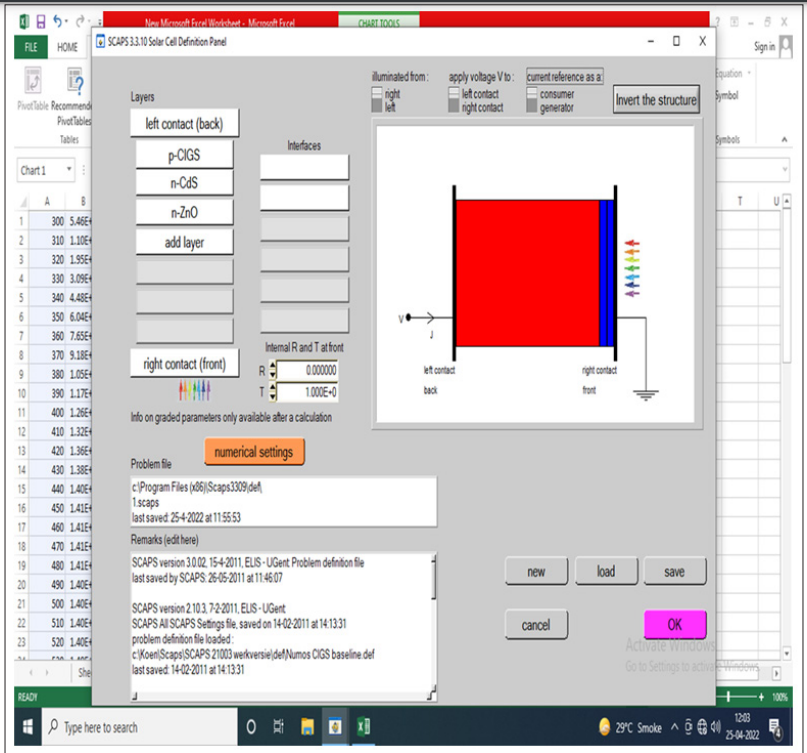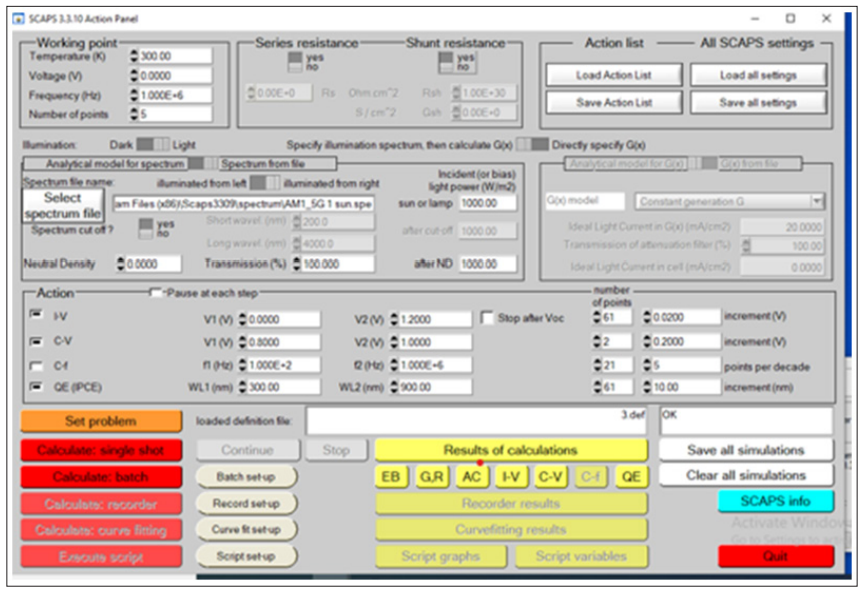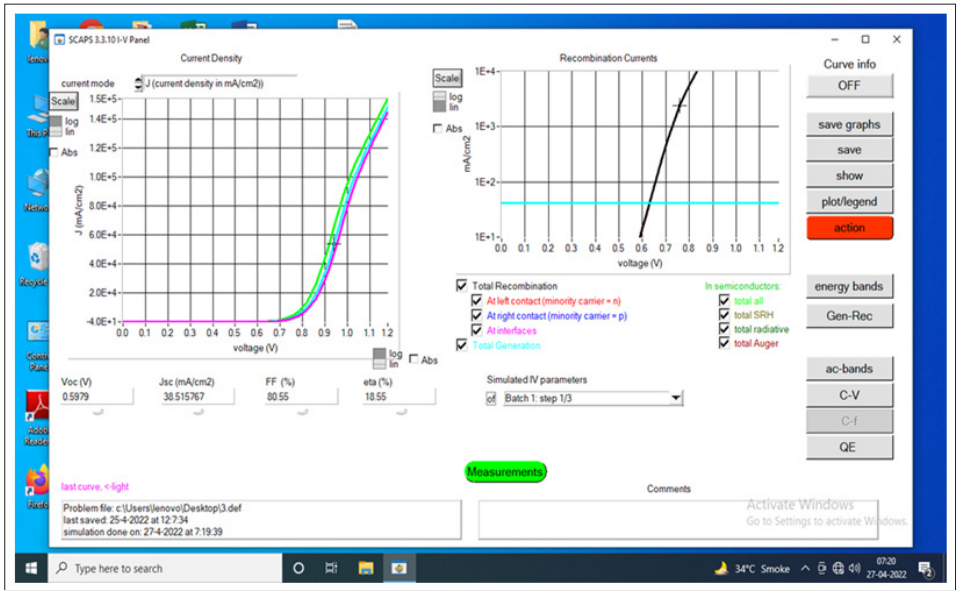Author(s): Dipika B Patel*, Nimish H Vasoya and Heta Patel
The imminent depletion of conventional energy sources has motivated the advancement of renewable energy technologies. Third-generation photovoltaic technologies, such as dye-sensitized solar cells (DSSCs), organic solar cells (OSCs), and perovskite solar cells (PSCs), are being developed as alternatives to silicon solar cells. These technologies have not yet reached the maturity required for large-scale commercialization. More research is required in order to improve the efficiency of these solar cells, while keeping their production costs to a minimum. In this study, a comparative assessment of Dye-sensitized solar cells (DSSCs), Organic solar cells (OSCs), and Perovskite solar cells (PSCs), is conducted. The comparative advantages and limitations of each of these photovoltaic technologies are assessed in terms of device efficiency, durability, fabrication, and performance and find the which solar cell is best among these three.
The sun is Earth’s natural power source, driving the circulation of worldwide wind and ocean currents, the process of water evaporation and condensation which creates rivers and lakes, and 2 biological cycles of the photosynthesis and life. On covering 0.61% of the land on the Earth with 10% capable solar conversion systems would supply 20 TW of power, nearly twice the world’s consumption rate of fossil energy the equivalent 20,000 GW nuclear fission plant. These comparisons demonstrate the impressive magnitude of the solar resource, providing an energy steam far more potent than present day human technology can achieve. All routes for utilizing solar energy use the functional steps of capture, conversion, and storage. The sun’s energy reaches on the Earth as radiation distributed across the color spectrum from infrared to ultraviolet. The energy of this solar radiation must be capturing as excited electron-hole pairs (excitons) in a semiconductor, a dye, or chromospheres, or as heat in a thermal storage medium. Excited electrons and holes can be tapped off abrupt conversion to electrical power, or transferred to biological or chemical molecules for conversion to fuel. Natural photosynthesis produces fuel in the form of sugars and other carbohydrates taking from the reduction of CO2 in the atmosphere and used to power the growth of plants. The plants themselves become available as biomass for combustion as primary fuels or for conversion in reactors to secondary fuels like liquid ethanol or gaseous carbon monoxide, methane and hydrogen. In the natural photosynthetic process in the laboratory using synthetic molecular assemblies, where the excited electrons and holes can drive chemical reactions to produce fuels that link to our existing energy networks. Atmospheric CO2 can be reduced to ethanol or methane or water can be split to create hydrogen. These natural fuels are the storage media for solar energy, bridging the day-night, winter summer and cloudy-sunny cycles of solar radiation. In addition to electric and chemical conversion process, solar radiation can be converted to heat energy. Solar concentrators focus sunlight collected over a large area to a line or spot where heat is collected in an absorber. Temperature as high 3,000 0C can be generated to drive chemical reactions or heat can be collected at lower temperatures and transferred to a thermal storage medium like water for distributed space heating or steam to drive an engine. Effective storage of solar energy as heat requires developing thermal storage media that accumulate heat efficiently during sunny-day and release heat slowly during dark or cloudy- day. Heat is one of the most adaptable forms of energy, the common connection in nearly all our energy networks, Solar thermal conversion can replace much of the heat now supplied by fossil fuel.
Third-generation photovoltaic technologies such as dye-sensitized solar cells (DSSCs), organic solar cells (OSCs), and perovskite solar cells (PSCs) are being developed as alternatives to silicon solar cells . In recent years, there has been increasing scientific interest in the development of these emerging photovoltaic technologies and their power conversion efficiencies (PCEs) have increased considerably.
These technologies need also to become cost-competitive with conventional power generation. The cost-effective deployment of photovoltaic (PV) systems is based on the following key requirements: (i) Minimum system cost (ii) Maximum initial performance (iii) Minimum loss of performance over time. These emerging photovoltaic technologies, although promising for sustainable solar energy applications, have not yet achieved large-scale commercialization. Research efforts are focused on increasing the efficiency and lifetime of these devices, combined with employing low-cost materials and processes.
Oza and Vasoya et al explore the modeling and simulation of a TiO2/GaAs solar cell using SCAPS (Solar Cell Capacitance Simulator) [1-2]. The authors aim to analyze the performance and efficiency of the solar cell through numerical simulations. The article begins by providing a brief introduction to the significance of solar energy and the growing demand for efficient solar cells. The authors emphasize the potential of GaAs as a promising material for solar cell applications due to its favorable properties. They also highlight the importance of TiO2 as a transparent conducting oxide layer in enhancing the overall performance of the solar cell. Next, the authors delve into the methodology, discussing the utilization of SCAPS software for the simulation process. They provide details on the various parameters, equations, and assumptions employed in the model to accurately represent the TiO2/GaAs solar cell. The results section presents the outcomes of the simulations, including the current-voltage (I-V) characteristics, power-voltage (P-V) curves, and external quantum efficiency (EQE) spectra. The authors analyze these results and discuss the performance enhancements achieved by incorporating the TiO2 layer.
A comprehensive overview of the fundamentals and current status of dye-sensitized solar cells (DSSCs) [3]. The authors aim to present a clear understanding of the working principles, materials, and advancements in DSSC technology. The introduction section offers a concise yet informative overview of the need for renewable energy sources and the potential of DSSCs in addressing this demand. The authors highlight the advantages of DSSCs, including cost-effectiveness, flexibility, and potential for efficiency enhancement. The article then delves into the fundamental concepts of DSSCs, discussing the key components such as the dye-sensitized semiconductor electrode, electrolyte, and counter electrode. The authors provide an indepth explanation of the photo-electrochemical processes involved in DSSCs, including light absorption, charge separation, and electron transport. Furthermore, the article reviews the recent advancements and emerging materials in DSSC technology. The authors discuss the progress made in dye development, electrode materials, electrolytes, and device architectures. They emphasize the importance of material engineering and optimization in enhancing the overall performance and stability of DSSCs.
An innovative approach to enhance the efficiency of quantum-dotsensitized solar cells (QDSSCs) by utilizing perovskite quantum dots [4]. The authors aim to demonstrate the potential of perovskite quantum dots as a sensitizer for achieving high-efficiency solar cells. The introduction section provides a brief overview of the growing demand for renewable energy sources and the potential of QDSSCs in addressing this need. The authors highlight the advantages of perovskite quantum dots, such as their narrow bandgap and tunability, which make them promising candidates for solar cell applications. The article then describes the experimental methodology and the synthesis of perovskite quantum dots. The authors discuss the fabrication process of the QDSSCs and provide details on the device architecture and materials used. Results show that the perovskite quantum dot-sensitized solar cell achieves an impressive efficiency of 6.5%. The authors analyze the performance characteristics, including current-voltage (I-V) curves and incident photon-to-electron conversion efficiency (IPCE) spectra, to evaluate the effectiveness of the perovskite quantum dots as sensitizers. So many authors have studied the efficiency and overall performance of each type of solar cell technology under various conditions and parameters [5-7]. This involves measuring key metrics such as conversion efficiency, power output, and stability. So author choose to study and compare dye-sensitized, organic, and perovskite solar cells driven by the importance of solar energy as a sustainable energy source, the diversity of solar cell technologies, the need for innovation and progress in the field, and the broader implications for academia, industry, and policy making for sustainable development of the earth.
In the present study author used SCAPS programme for developing solar cell. SCAPS (a Solar Cell Capacitance Simulator) is a onedimensional solar cell simulation programme. We used p-CIGS, n-CdS and n-ZnO type material to develop the solar cell. First of all to simulate this programme, and added layer option. In this add layer option first author add p- CIGS layer and then full filled other details like thickness band gap, electron affinity, relative dielectric permittivity, CB effective density of state, VB effective density of state, electron mobility, hole mobility for pCIGS material. Further researcher has increased the thickness of p-layer which is 2.000µm.
Consequently, added n- CdS layer in programme and full fill same steps. Here we can see that there are several details we have to fill up, also it’s compulsory to give data of donor density and acceptor density. Here we need to take particular number which is suitable to type of material. After that once we fill up all the data, further step is accepting. You can see in the image which is highlighted by pink color.
After adding all material details below picture shows our developed soar cell. In this solar cell radiation is apply from the front side of solar cell. It will show one combine figure 2 of n-type and p-type material.

Figure 1: Layer parameters like band gap (eV), electron affinity (eV), dielectric permittivity (ε*) etc. for solar cell simulation

Figure 2: The setup of the simulated solar cell
You can invert structure also. After doing all this thing click “ok”. It will show below data.
After that we set voltage to study the C-V, I-V and QF characteristics measurements. For C-V characteristic voltage was V1 = 0.01V and V2 =1.2V. For I-V characteristic V1 =0.8v, V2 =1.00v. For Quantum efficiency, first wavelength author has selected was 300nm and second wavelength was 900nm. In batch setup option author have added three different thickness for p-Layer material which is between 1µm to 3µm.
Here we have to switch on light illumination. These all material is stay for only small surface area. Further we can select different characteristics option which are I-V, C-V, C-F, QE. Then we can calculate single-shot. Also, in batch set up you can add different thickness of materials and plot a graph according to it. In result we can see different graph of characteristics with calculation as shown in Figure 3.

Figure 3: SCAPAS Action Panel for selection of various characteristics
The results of the comparative study indicate a clear trend: as the p-layer thickness increases, the efficiency of the solar cells also increases. The efficiency improvement with increasing p-layer thickness was observed consistently across all three types of solar cells, albeit with some variations.
In dye-sensitized solar cells, increasing the p-layer thickness enhanced light absorption, leading to increased charge generation and improved efficiency. The increased thickness also facilitated better charge extraction from the dye-sensitized layer, reducing losses and improving overall efficiency.
In organic solar cells, the thicker p-layer contributed to a better balance between exciton diffusion length and charge transport, resulting in enhanced charge collection and improved efficiency. The increased thickness of the p-layer also mitigated recombination losses, leading to higher overall efficiency.
Similarly, in perovskite solar cells, the thicker p-layer facilitated improved charge extraction and reduced recombination, thereby increasing the efficiency of the solar cells. The increased thickness of the p-layer enhanced the extraction of photogenerated charges and contributed to a more efficient charge transport pathway.
The observed trend of increasing efficiency with increasing p-layer thickness can be attributed to several factors. Firstly, the thicker p-layer provides a larger volume for light absorption, allowing for enhanced photon absorption and increased charge generation. Secondly, the thicker p-layer improves charge extraction and collection by providing a more efficient pathway for charges to reach the electrode. Additionally, the increased thickness helps in reducing charge recombination losses, which further contributes to improved efficiency
It is important to note that there is an optimal p-layer thickness beyond which the efficiency improvement saturates or starts to decline. This optimum thickness may vary for different PV technologies and needs to be carefully determined through further experimentation and optimization.
The findings of this study highlight the significance of the p-layer thickness in determining the efficiency of dye-sensitized, organic, and perovskite solar cells. By optimizing the p-layer thickness, researchers and engineers can potentially enhance the performance of these solar cell technologies, leading to more efficient and cost-effective solar energy conversion.
After completing all this process, we can get graph with different band gap and efficiency. In below image we can see that from 0.8v graph will increase it shows current density as shown in Figure 4.

Figure 4: solar cell simulation output graphs of current density and recombination currents
Table 1 exhibits the variability in the thickness of the p-layer. This table provides a comprehensive overview of the different measurements observed for the p-layer thickness across various samples or instances. By presenting this information in a tabular format, it allows for easy comparison and analysis of the variations. Researchers or stakeholders can quickly identify the range, mean, and distribution of the p-layer thickness measurements, enabling them to draw insights and make informed decisions. The table serves as a valuable reference, contributing to the understanding and advancement of the field in which the p-layer thickness plays a crucial role.
Table 1: Shows Variation of Thickness of p-layer
| thickness of p-layer is 1µm | thickness of p-layer is 2µm | thickness of p-layer is 3µm | |
|---|---|---|---|
| Voc in volt | 0.597852 | 0.619617 | 0.630810 |
| Jsc in mA/cm2 | 38.51576729 | 39.87099342 | 40.36956817 |
| FF in % | 80.5543% | 81.9260 | 82.4239 |
| Efficiency in % | 18.5490% | 20.2396 | 20.9897 |
A simulated GPVDM solar cell was run to evaluate the Dyesensitized solar cells (DSSCs)'s potential as a power producer. The efficiency of energy conversion of a solar cell may be greatly improved by optimising the thickness of the layers of the various materials used in the cell. The simulation results improved when the thicknesses of the p-layer, increased 1µm to 3 µm, respectively. One manner in which PCE might be improved is by changing the layer structure and material composition and received 20.9897% efficiency with increasing thickness of p-layer.
